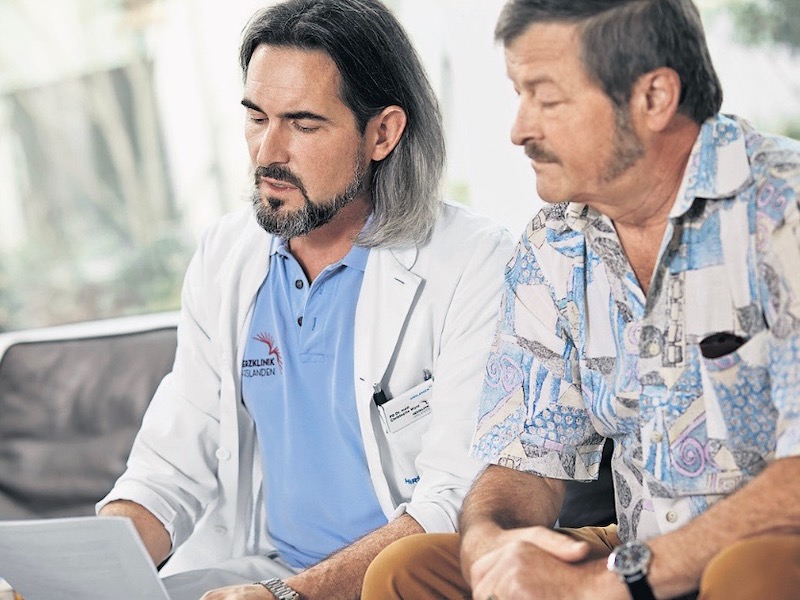Gentle heart surgery with the DaVinci robot
15 June 2018
Interview with Prof. Dr. med. Jürg Grünenfelder

Prof. Dr. med. Jürg Grünenfelder - Specialist Cardiac and Thoracic Vascular Surgery - HerzKlinik Hirslanden
The DaVinci surgical robot is mainly known from the field of prostate surgery. At HerzKlinik Hirslanden in Zurich, it has also been used successfully in cardiac surgery for years.
The "surgeon with four arms" does not tremble even once as he uses highly precise movements to remove part of the internal mammary artery, a small arterial branch in the chest cavity, for a bypass procedure. At the control console of the DaVinci surgical robot sits Prof. Dr. med. Jürg Grünenfelder, specialist in cardiac surgery and head of cardiac surgery at HerzKlinik Hirslanden in Zurich/Switzerland: "The robot can perform certain techniques better than a surgeon's hand.
The arms have a better freedom rotation than the human wrist. Any tremors are filtered out. And instead of standing bent over the patient for a long time, I sit at a comfortable workstation that prevents premature fatigue and can move two of the four robotic arms at a time.
All this with excellent visibility: one arm guides a camera with up to 10x magnification, the other three carry the necessary instruments." Prof. Grünenfelder and his team have been performing robot-assisted bypass operations at HerzKlinik Hirslanden for four years, and mitral valve reconstructions for 1.5 years.
Gentler heart operations thanks to DaVinci
The great advantage of using the surgical robot is the minimally invasive access to the chest cavity, explains Prof. Grünenfelder: "When we harvest a graft by hand, i.e. prepare a part of an artery that we want to use as a bypass, we have to spread the ribs by hand to have room for our movements. In the process, it can also happen that a rib breaks.
For the arms of the DaVinci, on the other hand, only tiny, approximately 1-centimeter-long incisions are needed in the space between the ribs." The fact that the ribs do not have to be spread during robot-assisted heart surgery significantly reduces the trauma to the chest. Patients suffer less pain after the procedure. Wound healing is also much faster. "It's a win-win situation for the patients and us cardiac surgeons," emphasizes Prof. Grünenfelder. "However, the robot never replaces the experience of the surgeon. The latter must master the techniques he performs with the help of the DaVinci. This is the only way to achieve good results."
The gentler procedure is ultimately also what puts the costs for the use of the expensive surgical robot back into perspective, according to heart surgeon Grünenfelder: "Even if the pure surgical costs are higher with the DaVinci, these are saved post-operatively by a rapid recovery and low complication rates".
Robotics technology continues to gain ground
Until now, the DaVinci has only been used for surgical procedures in which the heart has to stand still, i.e. using the heart-lung machine. The heart surgeons at the Hirslanden Clinic have slowly moved on to the more difficult cases. "After the bypass operations, we have now reconstructed about 30 mitral valves with the DaVinci. Double valve operations are possible, but still the exception," says heart specialist Grünenfelder.
He assumes that the further development of the DaVinci will progress rapidly: "The manufacturing companies are already working on inserting the robotic arms through only one access (single port) instead of four incisions in the future. This would again significantly reduce the burden on the patient." The first use of a DaVinci surgical robot with a single port could take place in urology or visceral surgery as early as next year.
If this method works, robot-assisted surgery for mitral valve reconstruction could become the standard procedure in two to three years, hopes Prof. Grünenfelder. Mitral valve insufficiency often remains undetected. The diagnosis is usually made when an unusual heart murmur is detected during the annual check-up with the family doctor. If the disease remains untreated over a longer period of time, it can become noticeable through reduced performance, impaired heart function, atrial fibrillation or an enlarged heart. People aged 60 and over are usually affected.
(Text source: Susanne Amrhein from PRIMO MEDICO)
More reports
Cardiac Imaging (Heart Imaging)
Techniques of imaging the heart (cardiac imaging): Imaging the heart (cardiac imaging) is indispensable for making a diagnosis....
HerzTeam: Experience is decisive
The experience of the heart team is crucial Stenosis and leakage of the heart valve are among the most common structural heart diseases. The...
Heart attack - Precious minutes
Every minute is precious in a heart attack The earlier a heart attack is treated, the higher the chance of survival and the...
Successful reconstruction of the tricuspid valve
Ernst Spalinger has confidence in his heart again. After the operation on the tricuspid valve, fear and shortness of breath are blown away....
Minimally invasive heart surgery
Prof. Dr. Jürg Grünenfelder, specialist in cardiac and thoracic vascular surgery at Herzklinik Hirslanden, is a specialist in minimally invasive...
Structural heart disease
What is structural heart disease? Structural heart disease refers to diseases of the heart that predominantly affect one of the four heart valves,...
All specialists at the Heart Valve Center of Herzklinik Hirslanden
Prof. Dr. med. ROBERTO CORTI
Interventional Cardiology
Prof. Dr. med. JÜRG GRÜNENFELDER
Cardiac Surgery
MD. THIERRY AYMARD
Cardiac Surgery
PD Dr. med. PATRIC BIAGGI
Cardiology | Imaging
Prof. Dr. med. OLIVER GÄMPERLI
Interventional Cardiology
PD Dr. med. DAVID HÜRLIMANN
Cardiology | Rhythmology
Dr. med. IOANNIS KAPOS
Cardiology | Imaging
MD. SILKE WÖRNER
Cardiology | Imaging
Prof. Dr. med. GEORG NOLL
Cardiology | Prevention
MD. IVANO REHO
Cardiology | Aortic Aneurysm
PD Dr. med. (H) DIANA RESER
Cardiac Surgery
Prof. Dr. med. JAN STEFFEL
Cardiology | Rhythmology
Prof. Dr. med. PETER M. WENAWESER
Interventional Cardiology
Prof. Dr. med. CHRISTOPHE WYSS
Interventional Cardiology





